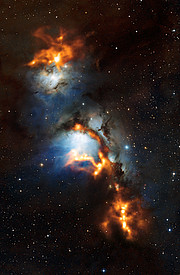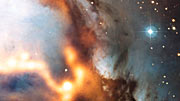Lehdistötiedote
Pölyn siivilöintiä Orionin vyön lähistöllä
2. toukokuuta 2012
Uudessa kuvassa heijastussumu Messier 78:aa ympäröivästä alueesta, joka sijaitsee aivan Orionin vyön pohjoispuolella, kosmiset pölypilvet pujottelevat sumun läpi kuin helminauha. Havainnot, jotka tehtiin APEX (Atacama Pathfinder Experiment) -teleskoopilla [1] hyödynsivät tähtienvälisten pölyhiukkasten lämpösäteilyä paljastaakseen tähtitieteilijöille uusien tähtien syntyalueet.
Pöly saattaa vaikuttaa tylsältä ja ikävystyttävältä - lialta joka kätkee taakseen kohteen kauneuden. Mutta tämä uusi kuva Messier 78:sta ja sen ympäristöstä, joka paljastaa alimillimetrialueen säteilyä avaruuden pölyhiukkasista, osoittaa että pöly voi olla häikäisevää. Pöly on tärkeää tähtitieteilijöille sillä tiheät kaasu- ja pölypilvet ovat uusien tähtien syntypaikkoja.
Kuvan keskellä on Messier 78, joka tunnetaan myös nimellä NGC 2068. Kun sitä havaitaan näkyvässä valossa, se on heijastussumu, mikä tarkoittaa, että näemme tähtien valon haalean sinisen hehkun pölypilvien heijastamana. APEX-havainnot on lisätty näkyvän valon kuvaan oranssilla. Koska APEX on herkempi pidemmille aallonpituuksille, sen havainnot paljastavat lempeän hehkun tiiviistä kylmistä pölymöykyistä, joista jotkut ovat jopa kylmempiä kuin -250°C. Näkyvässä valossa tämä pöly on tummaa ja peittävää, minkä takia APEXin kaltaiset teleskoopit ovat tärkeitä tutkittaessa pölyisiä pilviä, joissa tähdet syntyvät.
Yksi APEXin havaitsema filamentti näyttää näkyvässä valossa tummalta Messier 78:n ylittävältä pölyvanalta. Tämä tarkoittaa, että tiheä pöly sijaitsee heijastussumun edessä peittäen sen sinertävän valon. Toinen huomattava APEXin havaitsema hehkuvan pölyn alue osuu Messier 78:n alaosassa näkyvän valon emission alueelle. Vastaavan tumman pölyvanan puute näkyvän valon kuvassa paljastaa meille, että tämän tiheän pölyalueen täytyy sijaita heijastussumun takana.
Havainnot kaasusta näissä pilvissä paljastavat, että joistain tiheistä möykyistä virtaa kaasua ulos suurella nopeudella. Nämä ulosvirtaukset ovat peräisin nuorista tähdistä kun tähti on vielä muodostumassa sitä ympäröivästä pilvestä. Ulosvirtaukset ovat siten todisteita siitä, että näissä möykyissä on meneillään aktiivista tähtienmuodostusta.
Kuvan yläosassa on toinen heijastussumu, NGC 2071. Kun kuvan alemmissa osissa on vain pienimassaisia nuoria tähtiä, NGC 2071:ssä on yksi massiivisempi nuori tähti, jonka massan on arvioitu olevan viisinkertainen Aurinkoon nähden. Se sijaitsee APEX-havaintojen kirkkaimmassa kohdassa.
Tähän kuvaan käytettyjä APEX-havaintoja johti Thomas Stanke (ESO), Tom Megeath (University of Toledo, USA) ja Amy Stutz (Max Planck Institute for Astronomy, Heidelberg, Saksa). Lisätietoa tästä alueesta näkyvässä valossa, mukaan lukien vähän aikaan sitten löytynyt - ja voimakkaasti muuttuva - McNeilin sumu, löytyy aiemmasta lehdistötiedotteesta eso1105.
Lisähuomiot
[1] APEX on Max Planck Institute for Radio Astronomy:n (MPIfR), Onsalan avaruusobservatorion (OSO) ja ESO:n yhteistyöhanke. APEXin käyttö Chajnantorin tasangolla on annettu ESOn vastuulle. APEX toimii edeltäjänä seuraavan sukupolven alimillimetrialueen teleskoopille ALMA:lle (Atacama Large Millimeter/submillimeter Array), jota parhaillaan rakennetaan ja käytetään samalla tasangolla.
Lisätietoa
Euroopan eteläinen observatorio (ESO) viettää vuonna 2012 perustamisensa 50-vuotisjuhlaa. ESO on Euroopan johtava hallitustenvälinen tähtitieteen organisaatio ja maailman tieteellisesti tuotteliain tähtitieteellinen observatorio. ESO:lla on 15 jäsenmaata: Alankomaat, Belgia, Brasilia, Espanja, Iso-Britannia, Italia, Itävalta, Portugali, Ranska, Ruotsi, Saksa, Suomi, Sveitsi, Tanska ja T≈°ekin tasavalta. ESO toteuttaa kunnianhimoista ohjelmaa, joka keskittyy tehokkaiden maanpäällisten havaintovälineiden suunnitteluun, rakentamiseen ja käyttöön. Välineiden avulla tähtitieteilijät voivat tehdä merkittäviä tieteellisiä löytöjä. ESO:lla on myös johtava asema tähtitieteen tutkimuksen kansainvälisen yhteistyön edistämisessä ja organisoinnissa. ESO:lla on Chilessä kolme ainutlaatuista huippuluokan observatoriota: La Silla, Paranal ja Chajnantor. ESO:lla on Paranalilla Very Large Telescope (VLT), maailman kehittynein näkyvää valoa havainnoiva tähtitieteellinen observatorio, ja kaksi kartoitusteleskooppia. VISTA toimii infrapuna-alueella ja on maailman suurin kartoitusteleskooppi. VLT Survey Telescope on suurin varta vasten taivaan näkyvän valon kartoitukseen suunniteltu teleskooppi. ESO on maailman suurimman tähtitieteellisen projektin, vallankumouksellisen ALMA-teleskoopin eurooppalainen yhteistyökumppani. Parhaillaan ESO suunnittelee 40-metrin kokoluokan optisen/lähi-infrapuna-alueen European Extremely Large -teleskooppia (E-ELT) josta tulee maailman suurin tähtitaivasta havainnoiva silmä.
Linkit
Yhteystiedot
Thomas Stanke
ESO
Garching, Germany
Puh.: +49 89 3200 6116
Sähköposti: tstanke@eso.org
Douglas Pierce-Price
ESO ALMA/APEX Public Information Officer
Garching, Germany
Puh.: +49 89 3200 6759
Sähköposti: dpiercep@eso.org
Pasi Nurmi (Lehdistön yhteyshenkilö Suomi)
ESO Science Outreach Network
ja University of Turku
Turku, Finland
Puh.: +358 29 4504 358
Sähköposti: eson-finland@eso.org
Tiedotteesta
| Tiedote nr.: | eso1219fi |
| Nimi: | M 78, Messier 78, NGC 2068, Orion |
| Tyyppi: | Milky Way : Nebula : Appearance : Reflection |
| Facility: | Atacama Pathfinder Experiment |
Our use of Cookies
We use cookies that are essential for accessing our websites and using our services. We also use cookies to analyse, measure and improve our websites’ performance, to enable content sharing via social media and to display media content hosted on third-party platforms.
ESO Cookies Policy
The European Organisation for Astronomical Research in the Southern Hemisphere (ESO) is the pre-eminent intergovernmental science and technology organisation in astronomy. It carries out an ambitious programme focused on the design, construction and operation of powerful ground-based observing facilities for astronomy.
This Cookies Policy is intended to provide clarity by outlining the cookies used on the ESO public websites, their functions, the options you have for controlling them, and the ways you can contact us for additional details.
What are cookies?
Cookies are small pieces of data stored on your device by websites you visit. They serve various purposes, such as remembering login credentials and preferences and enhance your browsing experience.
Categories of cookies we use
Essential cookies (always active): These cookies are strictly necessary for the proper functioning of our website. Without these cookies, the website cannot operate correctly, and certain services, such as logging in or accessing secure areas, may not be available; because they are essential for the website’s operation, they cannot be disabled.
Functional Cookies: These cookies enhance your browsing experience by enabling additional features and personalization, such as remembering your preferences and settings. While not strictly necessary for the website to function, they improve usability and convenience; these cookies are only placed if you provide your consent.
Analytics cookies: These cookies collect information about how visitors interact with our website, such as which pages are visited most often and how users navigate the site. This data helps us improve website performance, optimize content, and enhance the user experience; these cookies are only placed if you provide your consent. We use the following analytics cookies.
Matomo Cookies:
This website uses Matomo (formerly Piwik), an open source software which enables the statistical analysis of website visits. Matomo uses cookies (text files) which are saved on your computer and which allow us to analyze how you use our website. The website user information generated by the cookies will only be saved on the servers of our IT Department. We use this information to analyze www.eso.org visits and to prepare reports on website activities. These data will not be disclosed to third parties.
On behalf of ESO, Matomo will use this information for the purpose of evaluating your use of the website, compiling reports on website activity and providing other services relating to website activity and internet usage.
Matomo cookies settings:
Additional Third-party cookies on ESO websites: some of our pages display content from external providers, e.g. YouTube.
Such third-party services are outside of ESO control and may, at any time, change their terms of service, use of cookies, etc.
YouTube: Some videos on the ESO website are embedded from ESO’s official YouTube channel. We have enabled YouTube’s privacy-enhanced mode, meaning that no cookies are set unless the user actively clicks on the video to play it. Additionally, in this mode, YouTube does not store any personally identifiable cookie data for embedded video playbacks. For more details, please refer to YouTube’s embedding videos information page.
Cookies can also be classified based on the following elements.
Regarding the domain, there are:
- First-party cookies, set by the website you are currently visiting. They are stored by the same domain that you are browsing and are used to enhance your experience on that site;
- Third-party cookies, set by a domain other than the one you are currently visiting.
As for their duration, cookies can be:
- Browser-session cookies, which are deleted when the user closes the browser;
- Stored cookies, which stay on the user's device for a predetermined period of time.
How to manage cookies
Cookie settings: You can modify your cookie choices for the ESO webpages at any time by clicking on the link Cookie settings at the bottom of any page.
In your browser: If you wish to delete cookies or instruct your browser to delete or block cookies by default, please visit the help pages of your browser:
Please be aware that if you delete or decline cookies, certain functionalities of our website may be not be available and your browsing experience may be affected.
You can set most browsers to prevent any cookies being placed on your device, but you may then have to manually adjust some preferences every time you visit a site/page. And some services and functionalities may not work properly at all (e.g. profile logging-in, shop check out).
Updates to the ESO Cookies Policy
The ESO Cookies Policy may be subject to future updates, which will be made available on this page.
Additional information
For any queries related to cookies, please contact: pdprATesoDOTorg.
As ESO public webpages are managed by our Department of Communication, your questions will be dealt with the support of the said Department.






